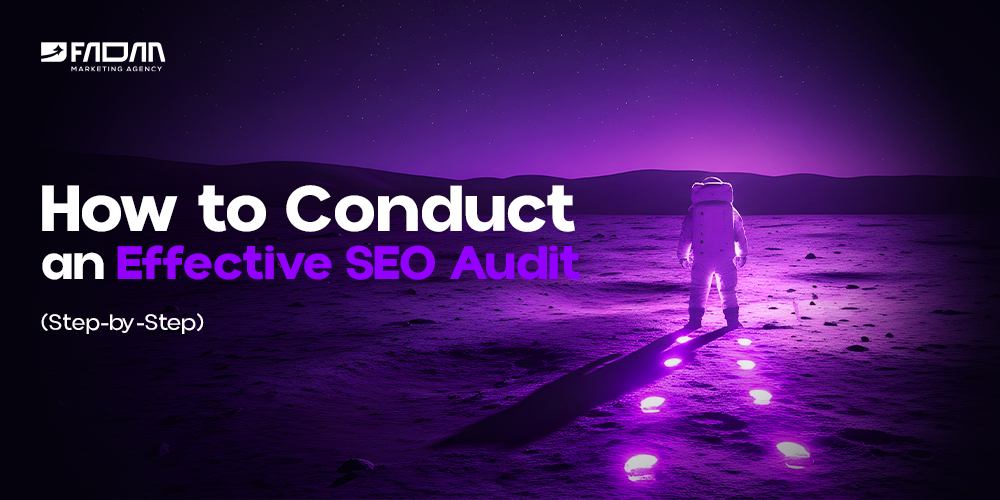If you want your website to perform at its best, ranking high on search engines and delivering a great user experience, there’s one thing you can’t skip: a comprehensive SEO audit. At Fadaa Marketing Agency, we help businesses grow by showing them how to conduct an effective SEO audit that reveals hidden issues and unlocks new growth opportunities.
In this detailed guide, you’ll learn exactly how to conduct an effective SEO audit—step by step—to ensure your site meets the latest SEO best practices in 2025.
An SEO audit is a complete review of your website to assess how well it’s optimized for search engines like Google. It includes checking technical performance, on-page and off-page SEO, user experience, content quality, and more. The goal is to identify issues holding your site back and find opportunities to improve visibility and traffic.
Conducting an effective SEO audit helps you:
Find and fix SEO issues before they hurt your rankings
Improve website speed, usability, and crawlability
Strengthen your keyword strategy
Increase organic traffic and conversions
Whether you’re launching a new site or improving an existing one, knowing how to conduct an effective SEO audit gives you a competitive advantage.
Use tools like Google Search Console to see which pages are indexed and identify crawl errors. Make sure:
Your robots.txt file isn’t blocking key pages
An XML sitemap is submitted and up to date
There are no major crawl or server errors
Google can’t rank what it can’t access—so this step is essential when you conduct an effective SEO audit.
Page speed directly affects rankings and user experience. Use PageSpeed Insights or GTmetrix to evaluate:
Largest Contentful Paint (LCP)
First Input Delay (FID)
Cumulative Layout Shift (CLS)
Optimize images, use browser caching, and minimize unnecessary scripts to improve loading time.
With mobile-first indexing, your site must perform well on all screen sizes. Use Google’s Mobile-Friendly Test to check:
Responsive design
Font sizes and spacing
Clickable elements
A mobile-optimized site is crucial if you want to conduct an effective SEO audit that reflects current search standards.
Go page by page and review:
Title tags and meta descriptions
Header tag structure (H1, H2, H3)
Keyword usage and intent alignment
Image alt text and internal linking
Consistency and keyword optimization help you maximize visibility.
Your content must be original, informative, and aligned with user intent. Check for:
Duplicate or thin content
Outdated posts or broken links
Missing content opportunities
Updating or expanding existing pages is often more powerful than publishing new ones.
Run a crawl with Screaming Frog or Sitebulb and look for:
Broken links (404 errors)
Duplicate titles or meta descriptions
Canonical tag issues
HTTPS status and site security
Technical clarity makes your site easier for search engines to understand.
Backlinks from trusted sites improve domain authority. Use tools like Ahrefs or Moz to check:
Number of referring domains
Toxic or spammy links
Anchor text distribution
A clean, healthy backlink profile is essential when you conduct an effective SEO audit.
UX factors indirectly influence rankings through bounce rate and dwell time. Look at:
Navigation and site structure
Readability and design
Engagement features (CTAs, forms, buttons)
Improving UX enhances your overall SEO performance.
Use Google Analytics and Search Console to analyze:
Organic traffic trends
Click-through rates (CTR)
Bounce rate and average session duration
Tracking these metrics before and after you conduct an effective SEO audit shows what’s working and where to focus.
Once your audit is complete, document your findings and set priorities. Categorize issues as:
High impact (fix ASAP)
Medium priority (address soon)
Low priority (monitor for now)
An actionable roadmap ensures improvements are made strategically, not randomly.
At Fadaa Marketing Agency, we don’t just run SEO audits—we craft custom strategies that turn data into results. Our expert team will:
Perform a complete technical and content audit
Identify hidden opportunities and ranking issues
Deliver a clear, actionable SEO roadmap
Whether you manage a small local business or a growing e-commerce site, we know how to conduct an effective SEO audit that fits your goals.
Knowing how to conduct an effective SEO audit is the first step toward stronger rankings, better user experiences, and more organic traffic. By following this step-by-step process, you can uncover the gaps in your SEO strategy and fix them with confidence.
Partner with Fadaa Marketing Agency for expert guidance and long-term SEO success. Let’s audit, optimize, and grow—together.
 June 15, 2025 - BY Admin
June 15, 2025 - BY Admin